Best dog playpens 2025 for your pooch to relax in
The best dog playpens keep your pooch out of trouble, giving them a safe place to play and relax.
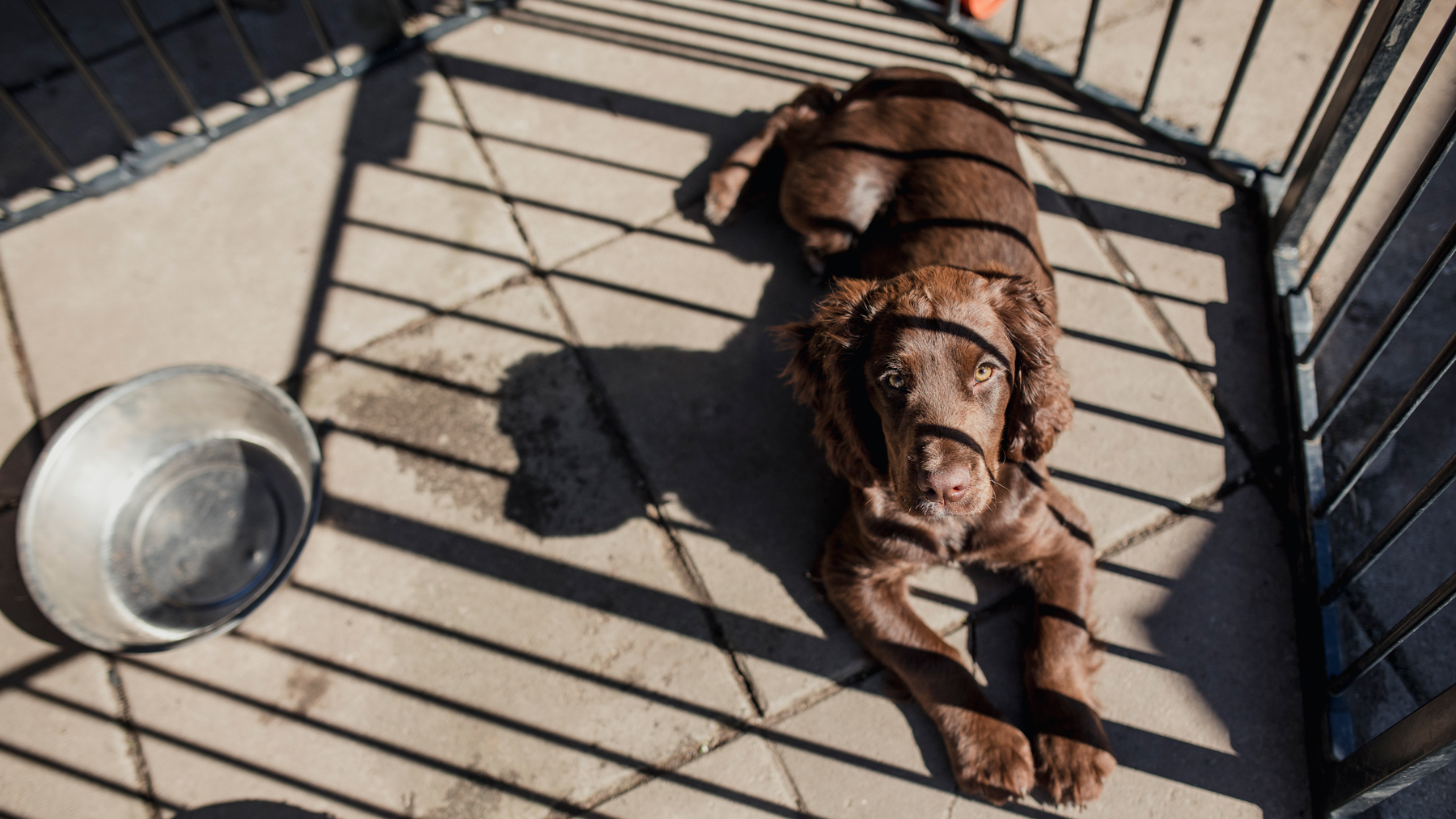
Give your pooch a safe and secure place to unwind with the best dog playpens. These handy structures are perfect for keeping your dog contained within a set space, giving you peace of mind while they play.
Dog playpens are ideal for dogs of all ages, but they’re especially useful when you’re training a young puppy. Keeping them in a designated area can keep any destructive behaviors, stopping them chewing on your sneakers or digging up the flowers in your garden. They are also great if you’re working from home, as you can keep them (and your home) safe while you take a meeting.
While dog playpens are a great playspace for your canine companion, don’t forget they need things to play with in there — make sure you throw a couple of the best dog toys or best dog puzzles in there with them.
When choosing the best dog playpens, the main things you want to consider are size and durability. On the size front, the size of your dog matters as much as the size of the playpen. You need to make sure they have enough room to move around and play comfortably, but you also want to make sure the playpen you give them is tough enough to keep them contained. If you want a playpen for outdoors, you also need to check that it can stand up to anything your local weather can throw at it.
The best dog playpens 2024
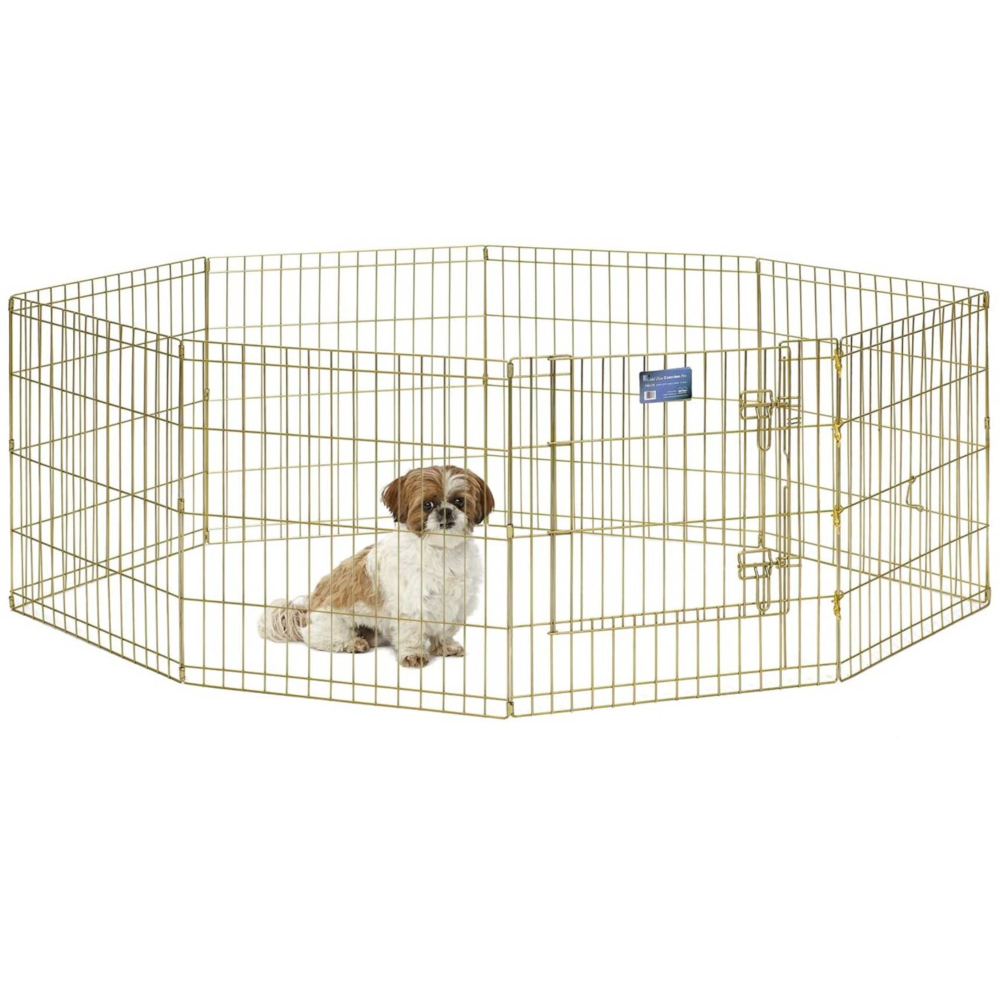
Best overall dog playpen
This foldable dog pen from Midwest offers the perfect blend of quality, affordability, and ease of use.
It has a sturdy metal construction with a stylish gold zinc finish, and the panels are super easy to construct (and pack away again when not in use). You can use this pen either indoors or outdoors, with ground anchors included in the box for outdoor use, plus corner stabilizers.
There are different height options available, depending on your dog breed, and you can even buy an optional top separately if you need to keep your high-jumping pooch contained. The panels only vary in height though — you don’t get more enclosed area — so this playpen is limited to small and medium-sized dogs.
Reasons to buy: Easy assembly
Reasons to avoid: Not suitable for large dogs
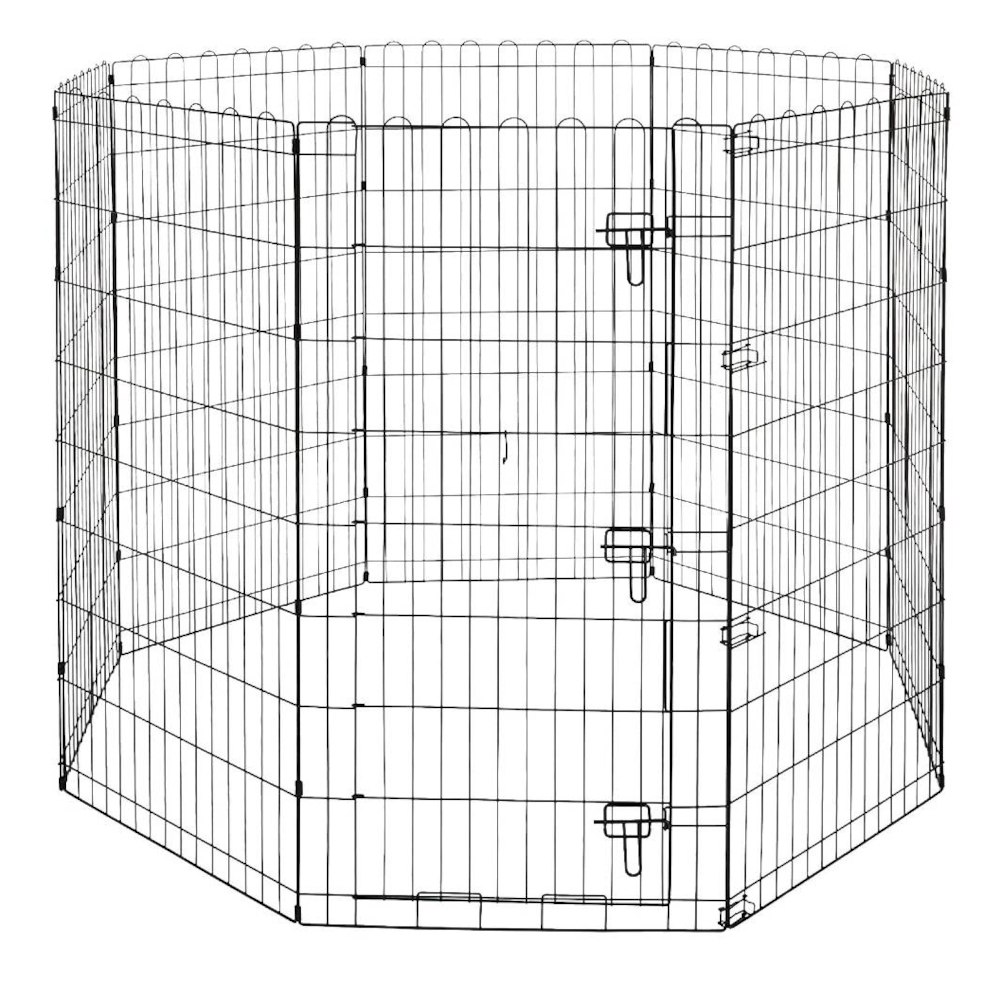
Best budget dog playpen
Anything you can do, Amazon can do cheaper with the Basics range. This budget dog playpen isn’t the sturdiest, so it’s not suited to large or boisterous dogs, but it offers great value for money for small-to-medium dog owners.
It comes in a variety of sizes, but the metal wire construction isn't the sturdiest, so it’s not suited to large or boisterous dogs. Despite that, it offers great value for money for small-to-medium dog owners. It has a black, rust-proof finish, it’s easy to set up and pack away, and flexible building options mean you can use it as either an enclosure or room divider.
The cheapest options are very barebones — you don’t even get a door, but you can spec up if you want a larger space and door, and it’s still going to be one of the cheaper options.
Reasons to buy: Good value
Reasons to avoid: Not super sturdy
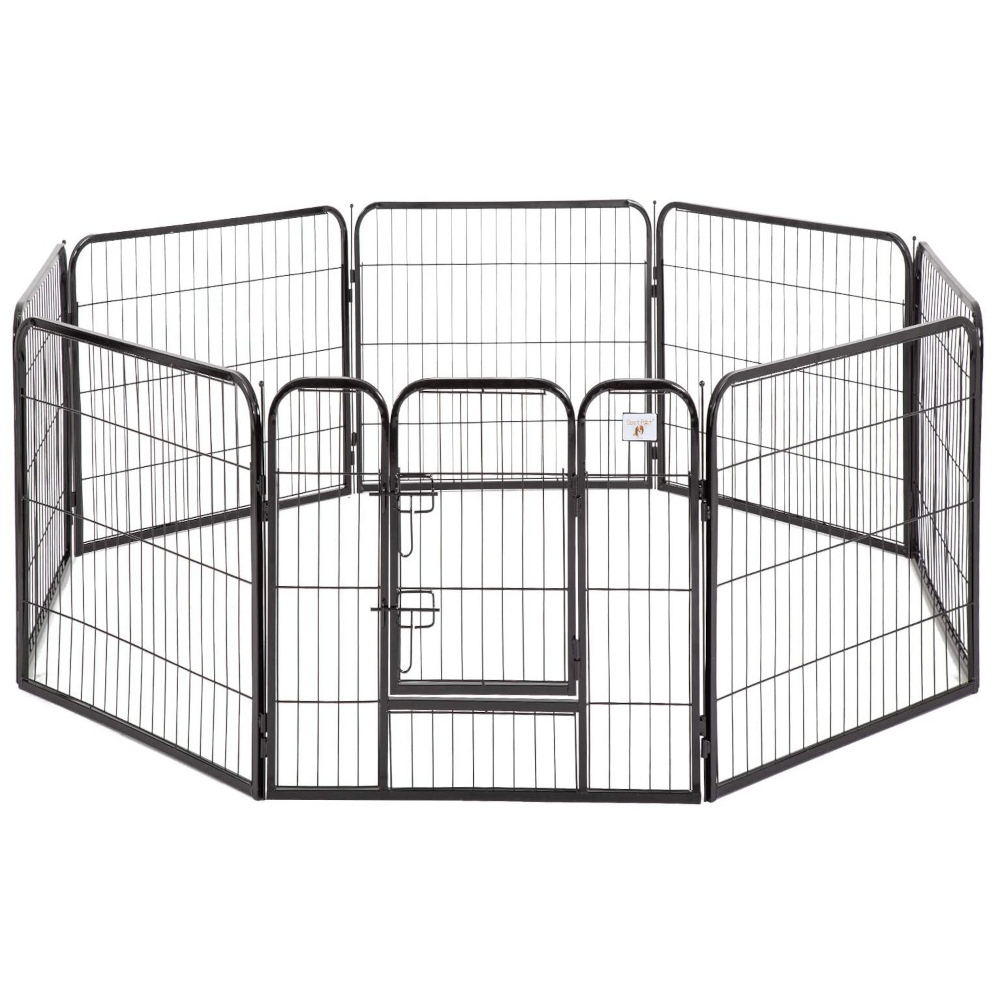
Best premium dog playpen
If you want a high-quality, exceptionally sturdy dog playpen then this absolute fortress from BestPet should be on your radar.
It can be used indoors, but it’s well-suited to outdoor use thanks to its heavy-duty construction and rust-resistant coated metal materials. It comes with an included door, and the whole thing can be easily constructed without tools. There are 8, 16, 24, and 32 panel versions on sale, and If you need to make it bigger, you can even attach multiple pens together for an even larger set up. There are also three different height options to choose from, depending on how tall your canine is.
It’s not cheap, but you’re getting a high quality product that you can trust will last, so we think it’s worth the price of admission.
Reasons to buy: Heavy duty
Reasons to avoid: Expensive
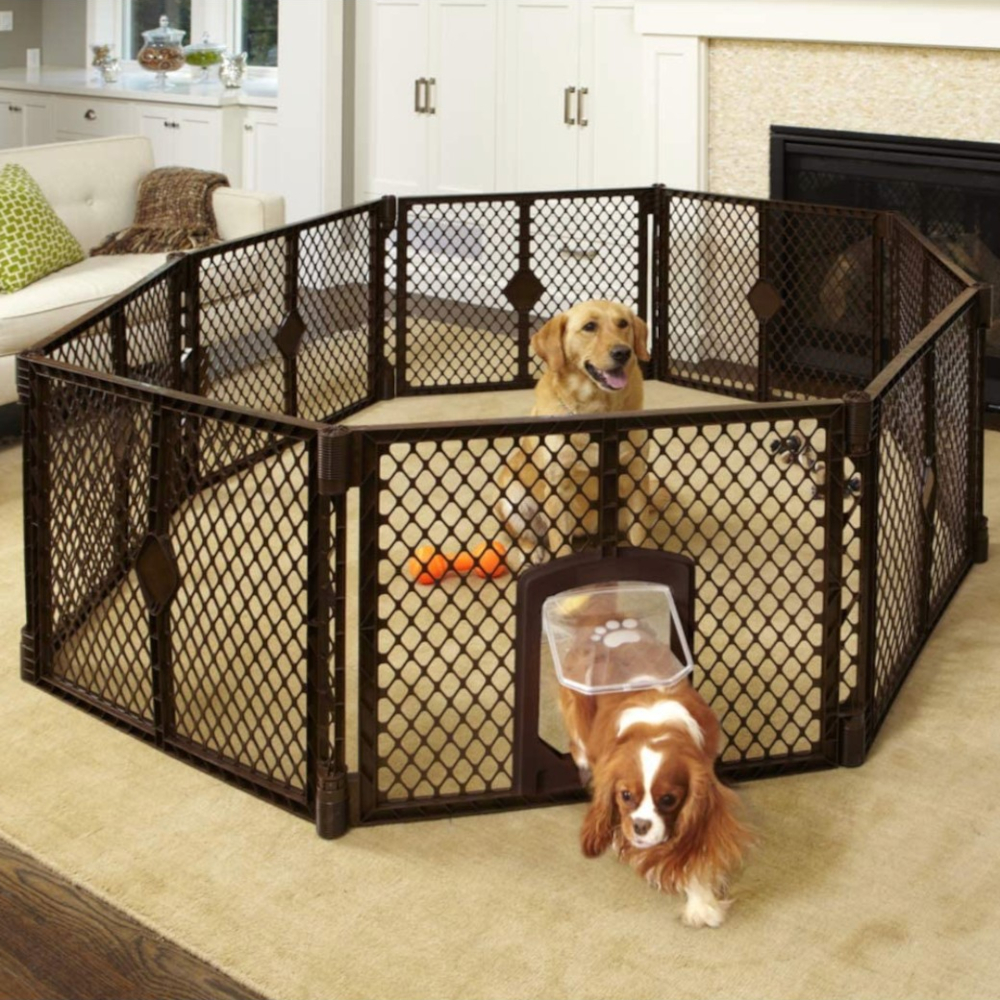
Best dog playpen with lockable pet door
This dog playpen features an ingenious swinging pet door that allows your pup to enter and exit the playpen as they please, but that also locks for those times when you're wanting to keep your furry friend securely contained.
Made from strong and durable plastic and with an attractive espresso brown finish that fits flawlessly with any decor, this playpen has eight panels that can be made bigger or smaller and configured to fit any space. The panels are foldable and come with a convenient travel strap, which makes this lightweight playpen ideal for taking with you wherever you go. It also has skid-resistant pads which hold it in place and protect your floors.
The only real downside is the limited height of the panels themselves — measuring in at 26-inches in height, they're brilliant for containing small to medium sized breeds, but we wouldn't recommend this model for larger dogs.
Reasons to buy: Convenient locking pet door
Reasons to avoid: Not suitable for tall dogs
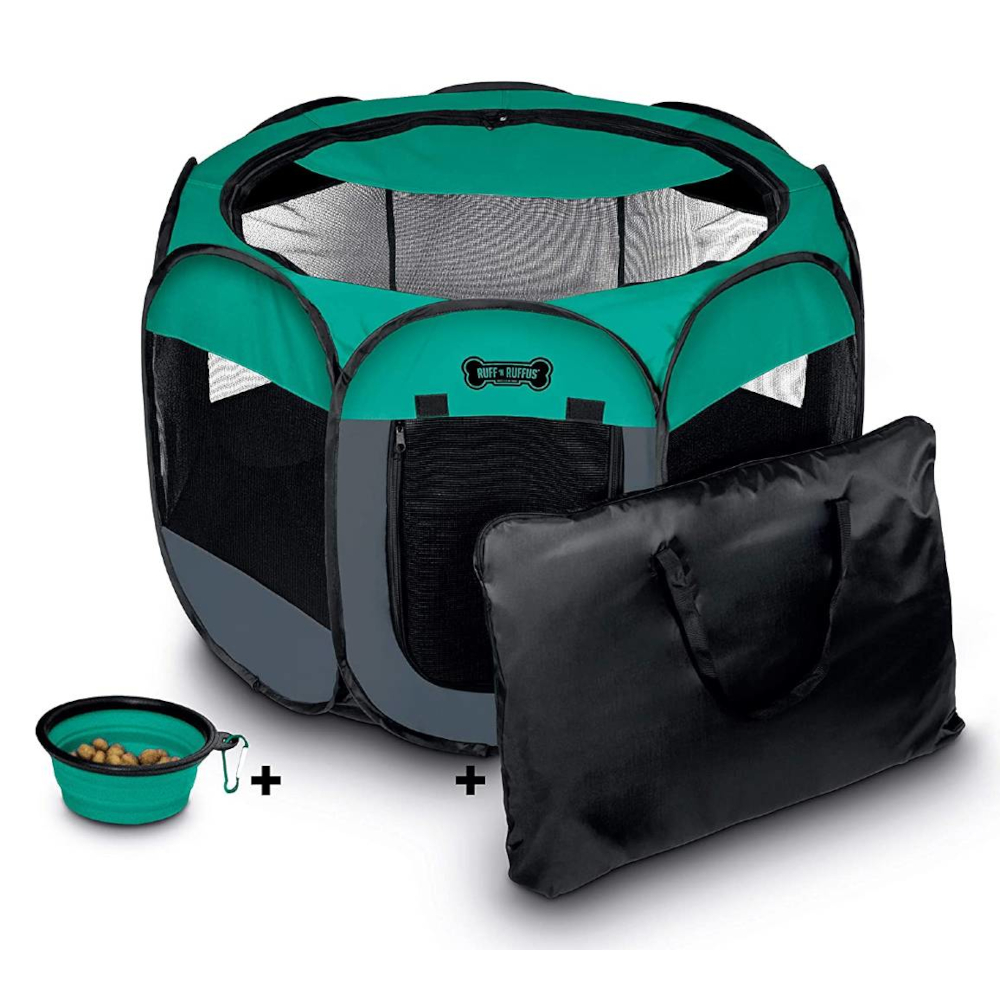
Best dog playpen for travel
This dog playpen is ideal for pet owners who like to travel with their dogs. Made from lightweight, water-resistant materials and available in a variety of sizes, the playpen offers easy assembly without hassle or tools.
When not in use, you can fold it flat and transport it with the included carrying case. This makes it perfect for taking pets out in public, whether it’s to the beach, or park for picnics. You can let them roam free most of the time, but still have a space to contain them when you’re busy eating or relaxing. It’s also perfect for pet owners who are traveling and aren’t sure how dog friendly their accommodation is going to be.
The playpen has a removable zippered top to provide extra security, or shade when in a sunny location, while still giving you the option of an open-topped doggy retreat. It’s quite expensive for its size, but we think the portability makes it worth the cost for adventurous dog owners.
Reasons to buy: Travel friendly
Reasons to avoid: Not very sturdy
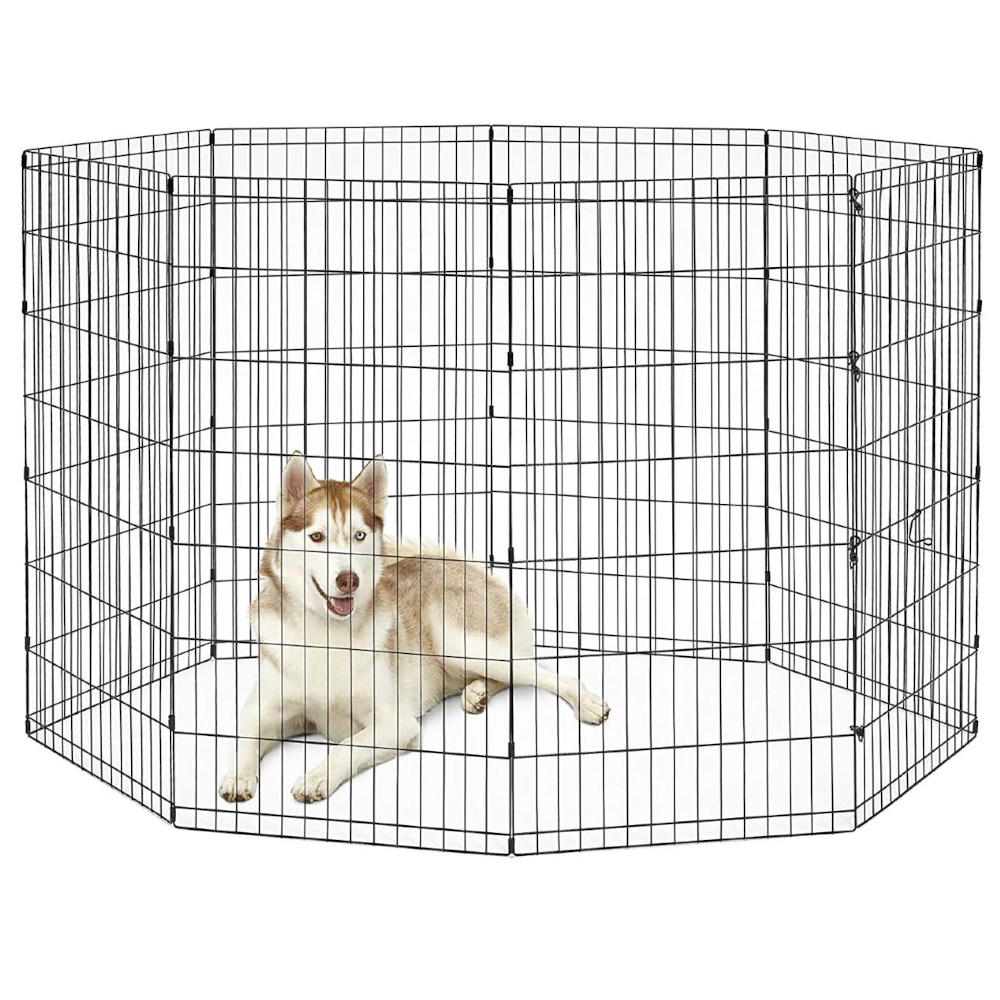
Best for large dogs
If you have an extra large dog, then you’ll need an extra large playpen if you want to keep them fenced in. This playpen comes in a variety of sizes, but the X-L option is our top pick for bigger hounds thanks to its impressive 48-inch height.
It’s hassle free to construct, and it folds down flat for easier storage when you’re not using it. Offering around 16 square feet of play space, it offers ample room for even the largest of pooches.
You can use it either indoors to block off certain areas, or construct it as a fully-enclosed pen either indoors or outdoors. The included ground stakes also mean it can be anchored outdoors, and the rust-resistant outer coat means you don't need to worry about bringing it back inside should the heavens open. The only real downside is the lack of a door, so you’ll need to unlock a panel to let your canine in and out.
Reasons to buy: Perfect for larger dog breeds
Reasons to avoid: No pet door
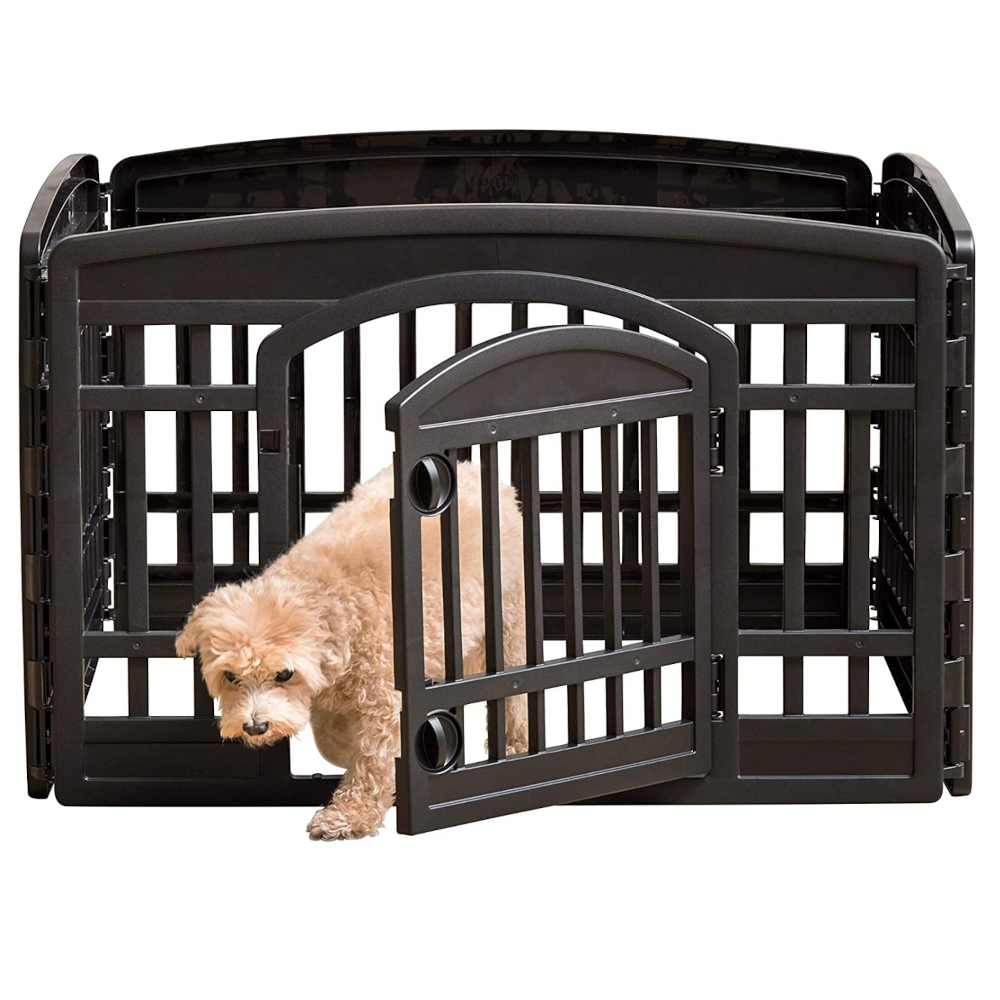
Best for small dogs
The IRIS 24'' 4-panel dog exercise playpen has its own access door, making it an ideal hideout for small pups who need a safe and secure place to play and rest.
It measures in at 36" W x 24" H and with an access door that's 15.75 inches wide and 18.88 inches in height. The durable molded plastic body means it's ideal for use both in the home and yard. That door also has a convenient twist locking mechanism to keep puppies and small dogs from wandering off. It also has non-skid rubber feet to protect your flooring and ensure that the playpen stays firmly fixed in place.
Providing 8 square feet of play space, the IRIS playpen features panels that snap together easily and because the design is so lightweight, it's a breeze to transport from A to B.
Reasons to buy: Ideal for smaller dog breeds
Reasons to avoid: Plastic body isn't very tough
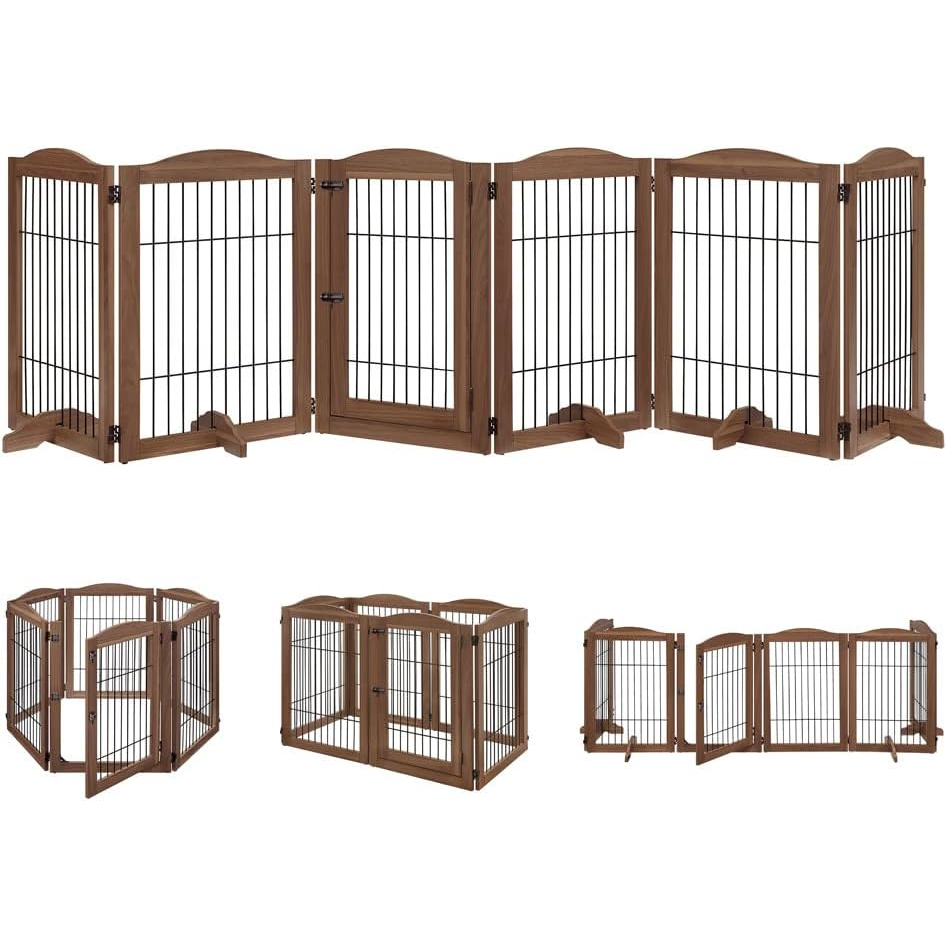
Best versatile dog playpen
If you’re looking for something with a touch of class, the stylish wooden build of this Unipaws dog playpen might pique your interest. It comes in four color options: White, Grey, Espresso, and Walnut — but that last one is our favorite for sure.
Composed of six foldable panels, it can be built as either a dedicated enclosure, or used as a divider to block off part of a room. It also comes with a lockable gate to let you pooch come and go as you desire. The anti-scratch, parallel feet give the playpen added stability while keeping your precious floors safe.
The wooden build does mean that this playpen is only suitable for indoor use though, as it won’t stand up to the elements. But if you want a classy playpen for your canine to use indoors, this is the one.
Reasons to buy: Looks very stylish
Reasons to avoid: Indoor use only
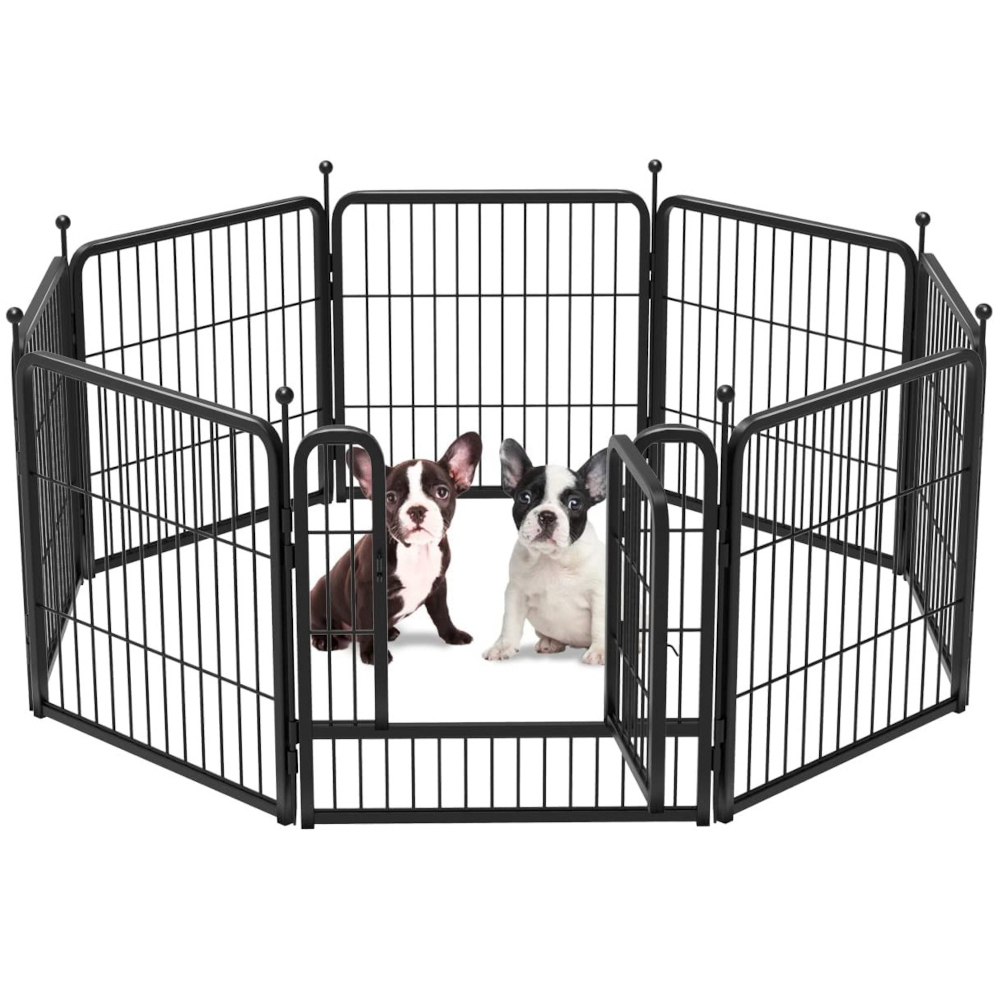
Best heavy-duty dog playpen
If you have a particularly mischievous dog that’s always trying to breach the defenses, then this tough and sturdy dog playpen is just what they need.
Available in a range of sizes, from 24 inches all the way up to 50, the FXW Dog Playpen is incredibly easy to set up, taking no more than five minutes to assemble. It also has no predefined shape, so there are a number of ways in which to arrange the panels.
Moreover, there are safeguards included for if your dog tries to escape. Outdoors, the stakes can be embedded in the ground, making it even harder for prison-breaking pooches to knock over. Rounded ball tops are fixed to the top of the stakes to protect their paws and claws.
We have heard some complaints about rust though, so this playpen might not be the best choice for prolonged outdoor use.
Reasons to buy: Designed for security and safety
Reasons to avoid: Rust issues if used outdoors

Rebecca is a vet surgeon who graduated from the Royal Veterinary College in 2009. She has a wealth of experience in first opinion small animal practice, having done a mixture of day-to-day routine work, on-call emergency duties and managerial roles over the years. She enjoys medicine in particular and she is proud to have recently achieved a BSAVA postgraduate certificate in small animal medicine (with commendation). She writes on various feline and canine topics, including behavior, nutrition, and health. Outside of work and writing she enjoys walking her own dog, spending time with her young family and baking!
How to choose the best dog playpen
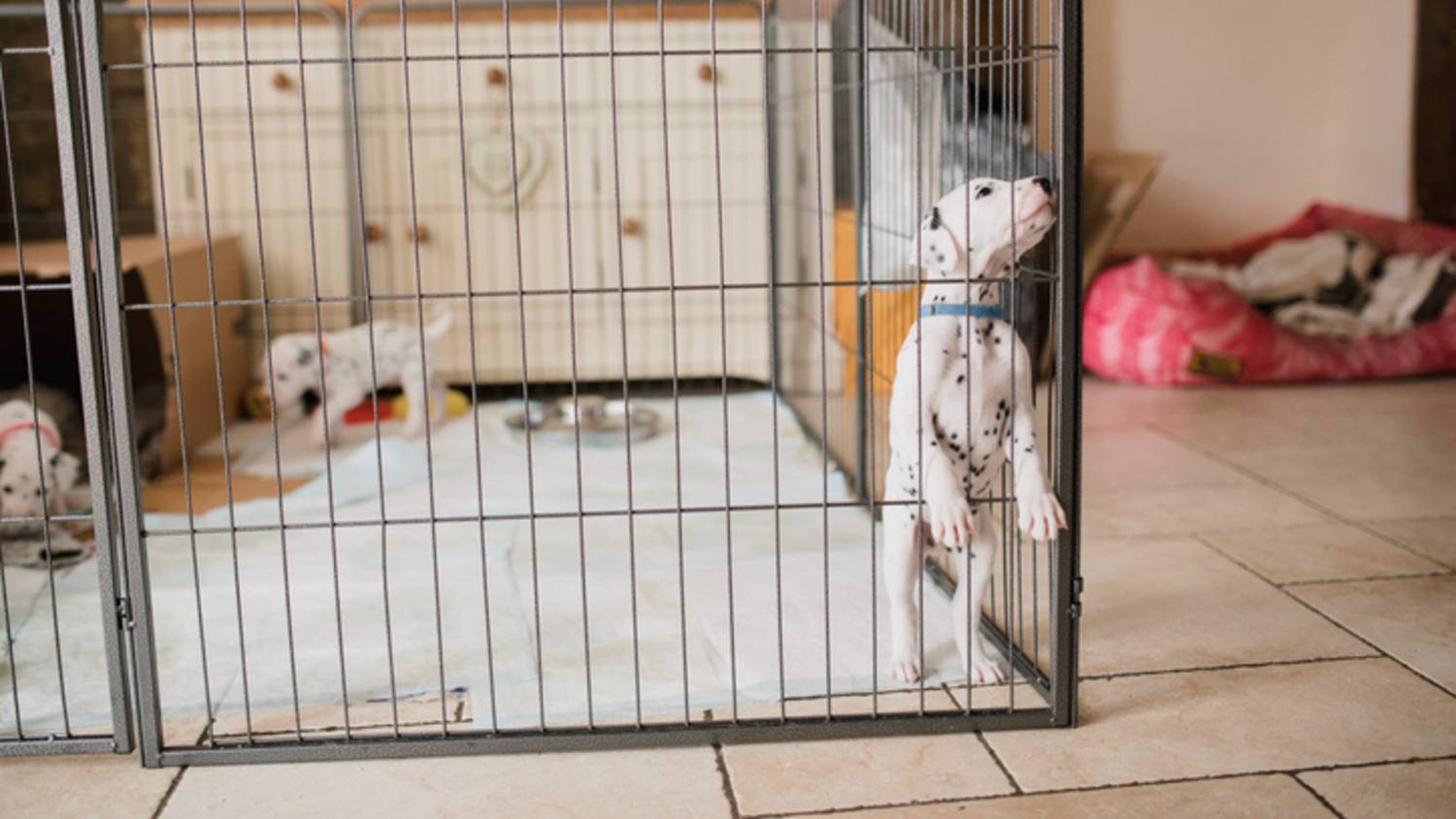
Height and weight
A dog playpen obviously needs to be able to contain your pooch appropriately. The size you need will of course depend on the size of your dog, as well as their ability to jump.
If you have a large dog who can easily scale obstacles, look for a playpen which offers plenty of height, or you could also look for those which offer the option of extending the height as they grow or get older.
Another alternative is to purchase a playpen cover which should keep your dog secure, as well as providing good shade if you’re intending to use the pen outdoors.
Weight is important for two different reasons - you’ll want to be able to manoeuvre the pen reasonably easily, but if it’s very light, you might find some strong dogs can lift it up and escape. Bear this in mind in relation to your own dog when choosing a pen.
Materials
Most playpens are made from metal wiring, which acts as a sort of cage for your dog. This helps to keep them contained without being too heavy or cumbersome.
Alternatively however, you might look for pens which are made from transparent or translucent plastic sheeting. This gives you a better sight of your dog from a number of different angles, so you might consider it to be more appropriate for your needs.
Entry and exit points
The cheaper dog pens often don’t include a door or gate for the dog (or you) to get in and out of the pen. That won’t be a problem for some dogs, but if you have one that you don’t want to lift in and out of the pen, it makes sense to get one with an inbuilt door for the easiest operability.
Some pens don’t have doors, but do have sections that can easily be released and move in a door-like way. It’s generally worth paying a little extra for an inbuilt door if you can, though.
Outdoor options
Have a think about how you intend to use your dog pen. If it’s for indoor use only, you might be able to get away with cheaper options that haven’t been designed to be particularly durable.
If however you’re wanting to give your pooch a run around outside to get some fresh air, you should look for those that feature rust-proofing, as well as coming with stakes to secure the pen to the ground. You’ll probably find that you don’t want the hassle of having to move the pen in and out of the house if you're using it frequently, so investing in one that can withstand various weathers makes a lot of sense.
How long should a dog be in a playpen?
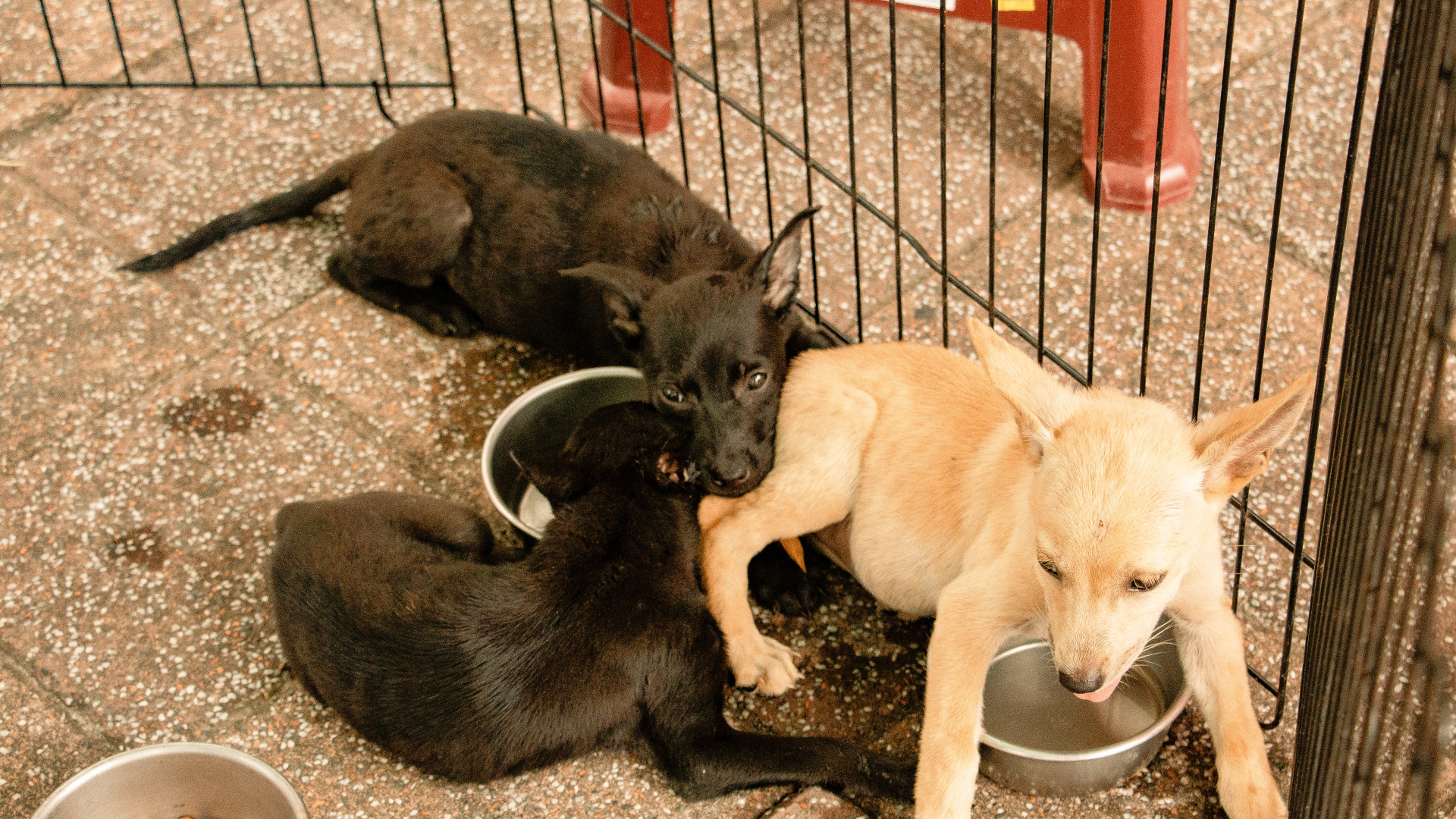
Dog playpens are an excellent way to keep your dogs safe and out of mischief, making sure they’re not chewing your home into pieces, but they’re not a permanent home for your pooch.
“As a rule, dogs should not be left alone for extended periods, whether in a playpen or free-roaming your house. It is recommended that adult dogs are left for no longer than 4 hours at a time, with puppies requiring even more regular attention for both toilet breaks and interaction.” says veterinary surgeon Rebecca MacMillan.
Playpens are suited to keeping your pets within a certain area, but you shouldn’t leave them alone for extended periods of time. That means no going to work for 8 hours and leaving your furry friend in the playpen. If you absolutely must leave them for an extended period of time, MacMillan says that you “must ensure that someone lets them out and checks on them during the day. This could be a family member, friend, or dog walker.”
Leaving your canine friend alone for longer will likely lead to them becoming bored and lonely, which in turn leads to unwanted behaviors like barking (which your neighbors will not thank you for), property destruction, and anxiety.
Is a dog playpen better than a dog crate?
"It is best not to compare a dog crate to a playpen directly, as they both serve different purposes" says Dr Rebecca MacMillan. "Depending on your needs and the set-up in your home, your puppy might need one or both of these items. This means that neither item is better than the other and you should instead consider the role that each one fills."
Dog crates
"Crates create a cozy, den-like environment which houses your dog’s bed. They give you the option of shutting your dog safely in at night, but the door is left open during the daytime so that they can come and go as they please." explains Dr MacMillan. "With the correct training, your dog should view the crate as their safe space and be willing to go into it of their own accord."
Another benefit of the best dog crates is that they can double up as transport solutions for your pooch. If you are going to transport your dog in the car using a crate, make sure it's crash-tested, for their safety and yours.
Playpens
While crates serve as a base of operations for your pooch, playpens should be viewed as a way of zoning off a safe area for your dog. As Dr MacMillan explains, within a playpen "your dog will have space to exercise and play, plus enough room for a bed, bowls and puppy training pad (if you are using one). They can explore the area independently without risking coming into contact with electrical wires, houseplants, or your possessions"
Because playpens offer a larger area than a dog crate, that also means that your pet can be left inside them for longer. MacMillan is quick to point out that they should still be regularly monitored though, as dogs can learn to jump out of crates and they could end up damaging your home or even injuring themselves.
Playpen vs Dog Crate
So there we have it. Neither a dog playpen or a dog crate is better. Instead, they serve different roles and both can be very useful tools for responsible dog owners. Dog crates give your pooch a safe space to rest at night, while playpens give them a confined space to explore and enjoy, without roaming into areas you'd rather they stay out of.
Get the best advice, tips and top tech for your beloved Pets

Jessica holds a journalism degree from Cardiff University and has authored articles for renowned publications, including PetsRadar, Fit&Well, LiveScience, Runner's World, The Evening Express, and Tom's Guide. Throughout her career in journalism she has forged connections with experts in the field, like behaviorists, trainers, and vets. Through her writing, Jessica aims to empower pet owners with accurate information to enhance their furry companions' lives.
- Ian StokesFreelance writer
